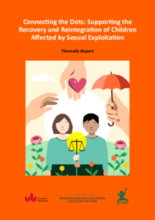The child protection sector lacks a robust evidence-base conveying what effective support during the recovery and reintegration process for children affected by child sexual exploitation (CSE) looks like. This report starts to collate evidence on what appears to be important to children who have experienced sexual exploitation. Recognizing the current gaps in knowledge, this report represents a first attempt to start ‘connecting the dots’ between primary data and existing literature to help states and service providers better respond to the needs of children affected by CSE. This report builds on the findings from field research carried out in Nepal, Thailand and the Philippines in 2015 with survivors of CSE and their service providers.
The report highlights findings related to children's care settings, including the difficulty for some groups to find suitable shelter and the long periods of time some children spent in shelter facilities as it was perceived that they could access better care and opportunities not available at home. The authors also noted concern that shelter facilities often appeared to be the only option, and that children were spending long periods of time in facilities that were designed for short term stays. Other findings related to care settings include:
- Survivor respondents shared that they needed clear information about care placements and needed to know if, why and where they may be moved to next.
- Survivor respondents expressed how small things made them feel welcomed and cared for when arriving at a new care setting; i.e., staff members talking to them, being asked if they were ok, and being offered food.
- A number of survivor respondents felt that movement between facilities was unhelpful and that they needed information to help prepare for moves.
- Survivor respondents talked about the difficulties they sometimes faced in shelter homes due to teasing, bullying and the everyday stresses of living with other children.
- Although some survivor respondents felt that physical security measures, such as having security guards at shelter homes, helped them feel safe, others did not understand why they were living in locked and guarded facilities.
- Survivor respondents shared that they had, or in some cases, were planning on running away from shelter facilities. For a number, this appeared to be due to the restrictions which meant they were unable to spend time, communicate with family or friends or ‘have fun’ outside the shelter.
- There is a need to recognise the value of building other dimensions of safety, alongside physical safety, such as relational safety, through establishing solid relationships between children and their caregivers.
- In understanding the importance of acceptance and belonging for children, organisations should prevent isolation and promote opportunities for children to build positive connections with family, friends and the community. Evidence suggests that such relationships will help build resiliency and enable smoother transitions.
The report also features key findings related to family and community strengthening and reintegration, including:
- Children have a right to family life and, where safe to do so, should be supported during reunification with family members.
- There are differing views over when children, if they are able, should return home and it is unclear how decisions are made on the ground, including who is involved in the decisions regarding reunification.
- Assessments are essential in establishing the readiness of the child, family and community for reunification and all relevant parties should be involved in this process
- Service providers must ensure that they are aware of legal frameworks and implement existing guidelines and procedures while making decisions regarding reunification.
- Service providers should prioritise working with and strengthening the family as this is key to successful reintegration.
- Children value and recognise the importance of being ‘accepted’ by their family and community and yet they may experience stigma and discrimination if they return home.
- There is a general need to work with communities on challenging discrimination and stigma against children affected by CSE.
- Monitoring children once they return home can be resource intensive and must be done with sensitivity so as not to further stigmatise children.
- Children should have access to long-term support accessible from their home communities. As specialist service providers may be unable to provide this support due to geographical barriers and resource constraints, it is important to explore the potential of working with local community organisations and structures to provide on-going support.
- Given the sensitive nature of this work, plans or activities involving the community should be fully considered, discussed with the child and family, and should assess risk to ensure that actions are appropriate, protect the child’s right to confidentiality and do no harm.

